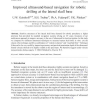Free Online Productivity Tools
i2Speak
i2Symbol
i2OCR
iTex2Img
iWeb2Print
iWeb2Shot
i2Type
iPdf2Split
iPdf2Merge
i2Bopomofo
i2Arabic
i2Style
i2Image
i2PDF
iLatex2Rtf
Sci2ools
84
Voted
CARS
2004
2004
Improved ultrasound-based navigation for robotic drilling at the lateral skull base
Sensitive structures of the lateral skull base demand for robotic procedures a higher precision than provided by standard navigation systems relying on CT scans. Keystone of our multisensor approach to improve accuracy is the use of ultrasound for local navigation. In this study we compare two different ultrasound techniques to measure human skull bone in vitro: (A) the classic echo technique and (B) a combination of ``coded excitation'' and ``matched filter'' Technique B showed to be very useful by improving accuracy and practical penetration depth of the ultrasound. Sound velocity showed to be highly variable in the specimens. We therefore suggest sound velocity measurements during surgery. D 2004 Published by Elsevier B.V.
| Added | 30 Oct 2010 |
| Updated | 30 Oct 2010 |
| Type | Conference |
| Year | 2004 |
| Where | CARS |
| Authors | U. W. Geisthoff, Steffen H. Tretbar, Philipp A. Federspil, P. K. Plinkert |
Comments (0)

